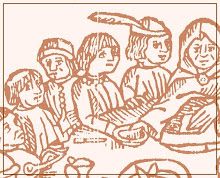Which I dismissed as an unfair judgement on a book I hadn't actually looked at very closely. But it got me thinking - I don't think I've ever come across anyone writing about the Middle Ages from the perspective of what I'm choosing to call temporal identity. National, obviously, religious, yes, social, financial, of course. But as being members of a body at a particular time in history, or as being defined as distinct from the actions of their forebears, or even descendants? Surely it's an idea that must hover around the edges of rather a lot of writing, particularly once we hit those highly visible events that cause rapid social change, oh, say, the Norman Conquest, or the Black Death. But each of those brings with it other identity factors that tend to steal the limelight: English/Norman, language, dispossession: economic crises that empower different social groups.
I suppose the instinctive reaction would be to say "oh, people in the Middle Ages just thought they were one big blob, they didn't differentiate from generation to generation". And even if one acknowledges a change in character from one century to the next, it's generally assumed, I think, that this is visible only in hindsight, that the lack of access to information about their own history made people only vaguely aware of it, a sort of mess of fable and tradition, there to inform and instruct but not necessarily something that they feel their times to be a unique part of.
But people do. We have, on the small scale, Gen X and Y, children of the nineties, sixties hairstyles and so forth. And if comic and satiric writing across the ages are anything to go by, the kernel of temporal identity - the griping against and between children these days/back in my day and the stodgy older generation - is as universal as fart jokes. Just ask Aristophanes. Once you have the basic them and us, and the sense of differentiation and movement that implies, the basic and possibly strongest form of time-based identity is there for the reaping. And repeating. And complaining about.
That doesn't necessarily lead to a larger perception of one's place in linear history, but there's no firm reason for it not to. Is this something we should be looking into? Or has it been, and I've just not noticed?
In fact, as it turned out, I hadn't looked at the book very closely at all. On passing it again later today I realised what it, and all its companion volumes, actually said on the spine: Dictionary of the Middle Ages.
Oh well!
[1] Gilbert and Sullivan, Patience, Bunthorne explaining to the audience how to best go about being "an aesthetic sham". For all those who, you know, didn't spend three years in their early teens being completely obsessed with them, which I realise is probably a substantial percentage of the population.


.jpg)


5 comments:
This is something that I have, in a small way, wondered about, and I do think we should be thinking about it more although my question is less about identity and more about if and how medieval people perceived large-scale social change. Nonetheless, these are, as the saying goes, two horns on the same goat. If you come up with any writing about this, though I suppose In the Medieval Middle is the place to ask, I'd like to know.
Meanwhile, I know that Discovery of the Individual book and it's every bit as annoying as you think. (See my mention here if you wish and didn't already).
Well, yes, it's not as if one would be covering new ground, really. But one sees the goat from a slightly different angle depending on which horn one chooses to examine, which is the fun thing. What if one horn had a little parasite on it that the other didn't? It could be affecting the health of the whole goat without our being aware of it!
I don't know if I'll do any work on it this year (or at all), but it will doubtless come up here if I do.
And if all one sees is the horns, we don't really know if it's a goat!
This is true! We are so used to seeing our sheep without horns nowadays that we might have entirely overlooked the possibility of it being a sheep! Or maybe even a small, fuzzy antelope.
The antelope of course a powerful allegory for the awareness change because of embodying an immanent 'before'! We need an epistemological osteoarchæologist, stat!
Post a Comment